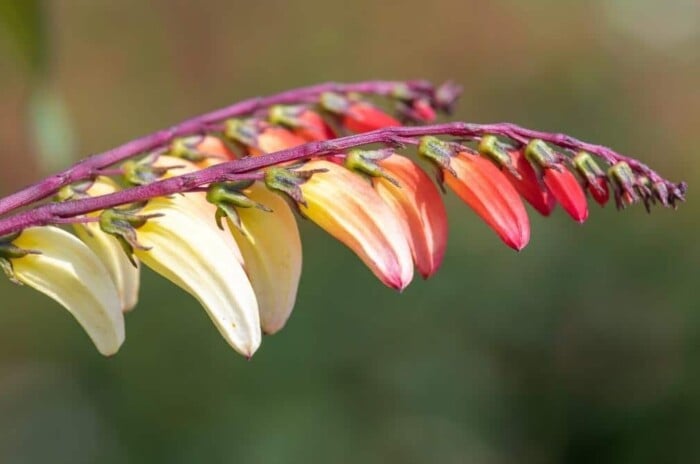21 Vines and Climbing Plants With White Flowers
Thinking of adding a white flowering vine to your garden, but aren't quite sure where you should start? There are many vines that sport showy white blooms, and many will climb rapidly without much maintenance. IN this article, we look at our favorite white flowering vines to help you find the best fit for your garden!
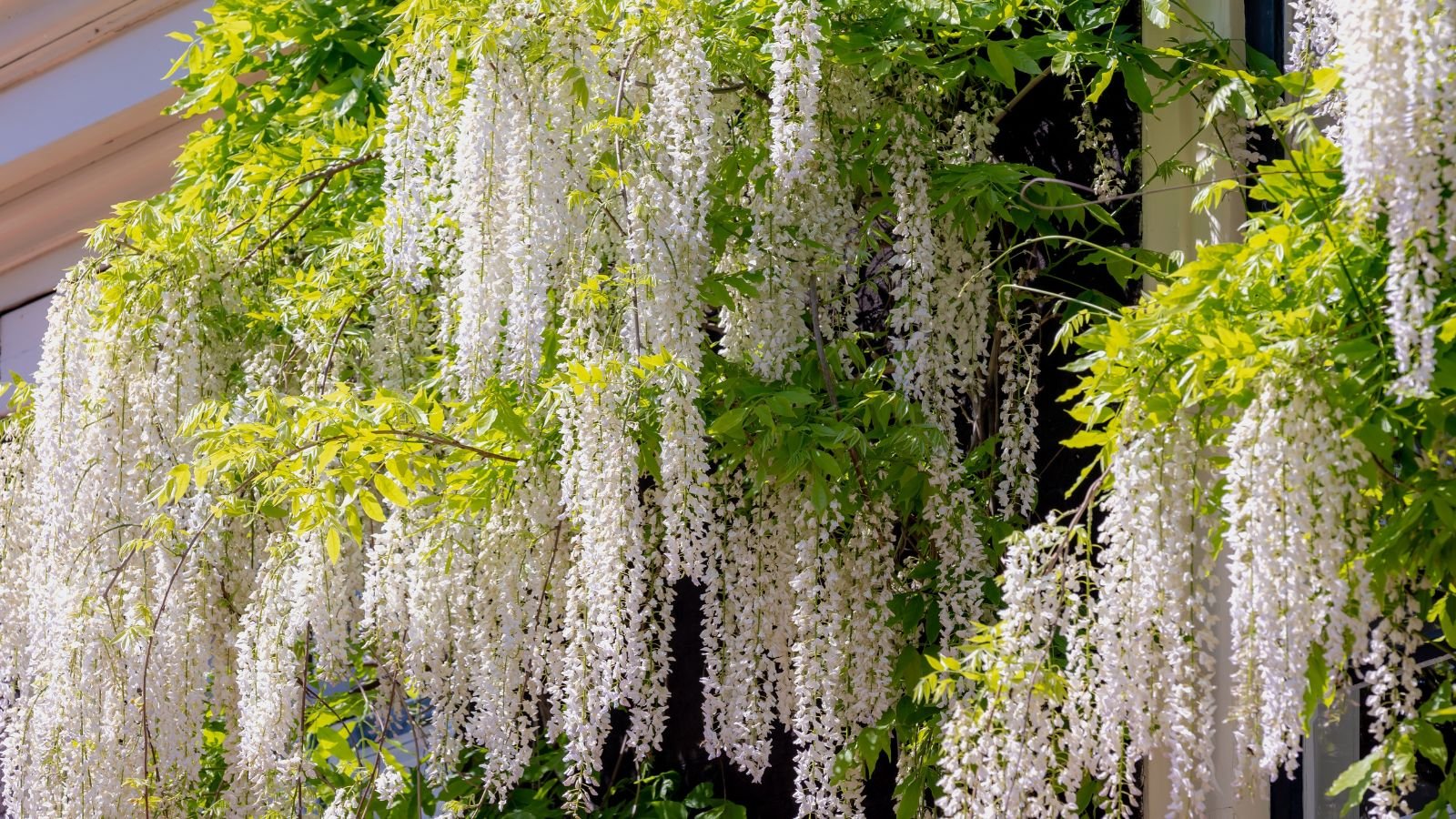
Contents
Looking to add excitement to your garden without overwhelming the harmony of your space? Consider adding some vines with white flowers to your garden this season! Most white flowering vines will add beauty, color, and texture to your garden.
You can plant them to cover up unsightly areas or to create a screen between you and your neighbors. In addition, they provide a source of nectar for pollinators like bees and butterflies. Vines with white flowers will also reflect light in shadowy areas, making them feel cozier.
Probably the best benefit from adding vines with white blooms is the fact that they won’t detract from other louder, bold flowers in your garden. You can go nuts adding brightly colored dahlias, or beautiful blue hydrangeas and provide a calm backdrop of vines with beautiful white blooms.
So, which vines should you choose? There are quite a few options to pick from, so let’s take a look at some of our favorites!
Bleeding Heart Vine

|
|
botanical name Clerodendrum thomsoniae |
|---|---|
|
|
plant type Perennial |
|
|
sun requirements Full sun to partial shade |
|
|
height 15 feet |
|
|
hardiness zones 9 |
The bleeding heart plant has delicate heart-shaped leaves and produces clusters of white flowers with red accents in the spring.
The bleeding heart plant grows best in moist, shady conditions and is often found in woodlands. You can propagate the plant using seed or division.
The leaves of the bleeding heart plant are poisonous if ingested in large quantities, and the sap can cause skin irritation. The plant is sometimes used as an herbal remedy for anxiety and insomnia.
Climbing Hydrangea
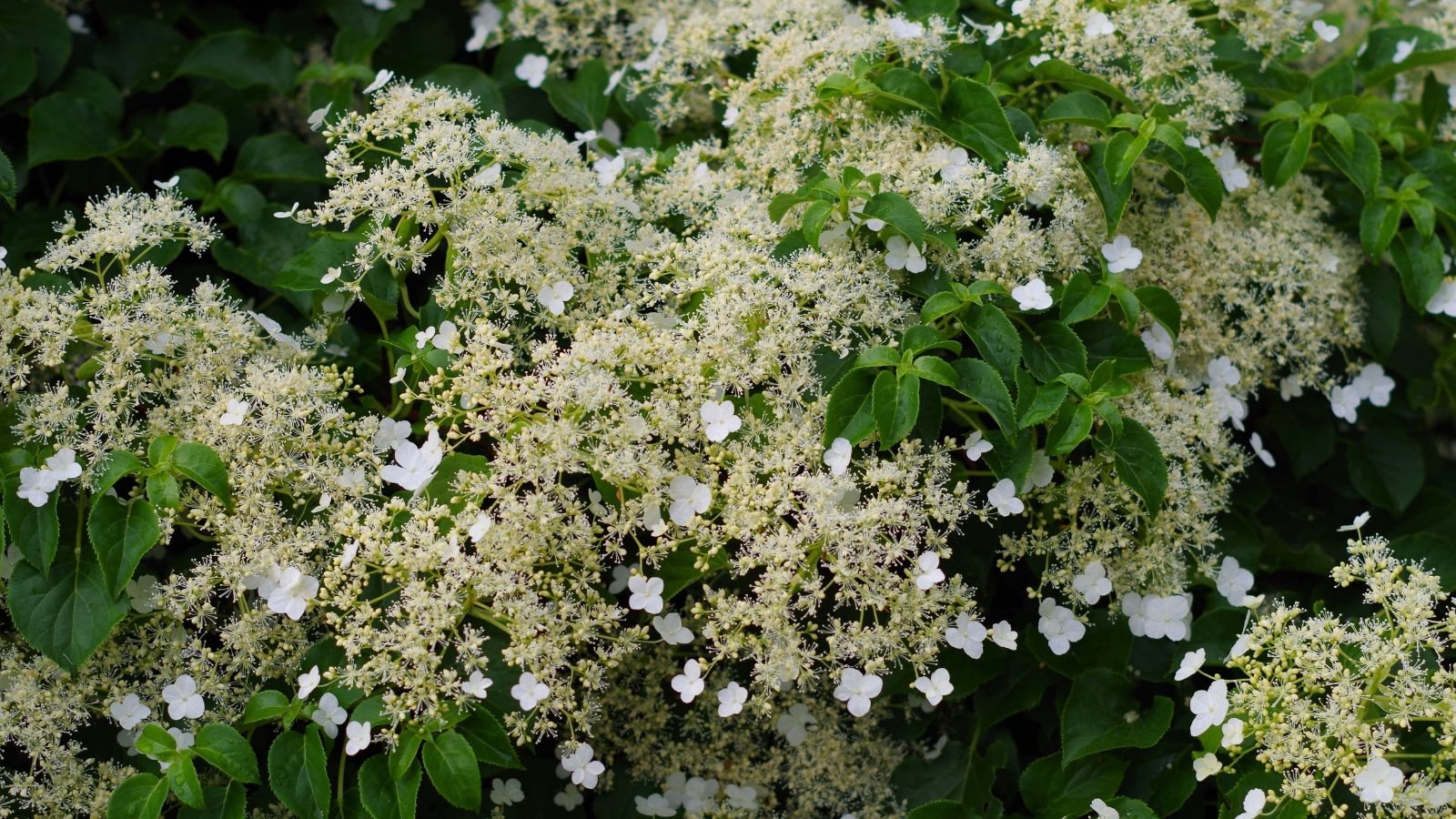
|
|
botanical name Hydrangea anomala |
|---|---|
|
|
plant type Perennial |
|
|
sun requirements Partial to full shade |
|
|
height 30-60 feet |
|
|
hardiness zones 4-8 |
If you’re looking to add some beautiful blooms to your garden, consider planting Hydrangea anomala! Hydrangea is easy to grow and comes in a variety of colors including pink, blue, and purple.
They bloom from early summer to fall and make excellent cut flowers. This vine can reach a height of 30 feet or more if given something to climb on. This vine is a good choice for covering a wall or fence. It is also deer resistant.
Climbing Jasmine

|
|
botanical name Jasminum polyanthum |
|---|---|
|
|
plant type Perennial |
|
|
sun requirements Full sun to partial shade |
|
|
height 15-20 feet |
|
|
hardiness zones 9-10 |
Jasmine flowers are small, but they pack a lot of fragrance. Jasmine is often used in aromatherapy because of its sweet smell. Not only does jasmine smell nice, but it is a beautiful addition to any garden.
Climbing jasmine is one of many different Jasmine varieties that you can grow, many of them with white flowers. It has a delicate fragrance that will fill the air. Once planted, they can climb a trellis or fence, or be kept in a pot.
Dewberry

|
|
botanical name Rubus fruticosus |
|---|---|
|
|
plant type Perennial |
|
|
sun requirements Full sun |
|
|
height 3-9 feet |
|
|
hardiness zones 5-8 |
Dewberry is also known as wild blackberry. Because it’s wild, the fruit is more tart than a blackberry. Before berries grow, you’ll enjoy gorgeous, delicate white flowers.
The berries will be a hit with birds in your garden, so if you’re a birdwatcher, you’ll enjoy dewberry beyond the flowering season. Because the dewberry plant is a wild variant, this isn’t the best option if you want a manicured garden. This is a great option to create a privacy fence or if you want a bit more of a “wild” look in your landscaping.
False Hydrangea Vine
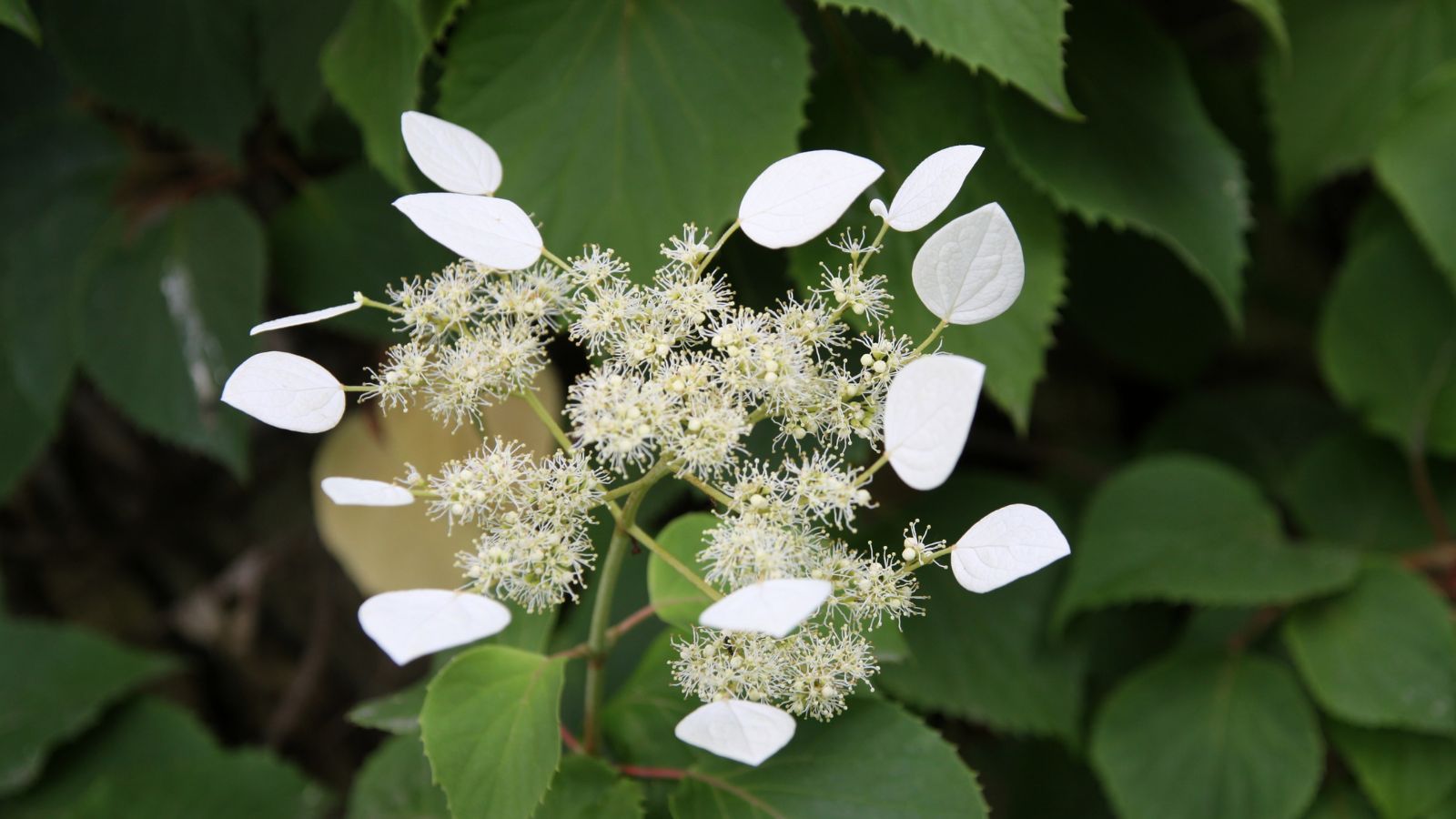
|
|
botanical name Schizophragma hydrangeoides |
|---|---|
|
|
plant type Perennial |
|
|
sun requirements Full sun to full shade |
|
|
height 30-40 feet |
|
|
hardiness zones 5-8 |
The false hydrangea vine is a bit of a wild plant and can be aggressive with growth. The white flowers grow in clusters and make a stunning display.
This vine is easy to care for and is a great choice for both beginners and experienced gardeners alike. The false hydrangea is a close relative of the hydrangea, but it has sterile florets, with a distinct shape.
Moonflower

|
|
botanical name Ipomoea alba |
|---|---|
|
|
plant type Perennial |
|
|
sun requirements Full sun |
|
|
height 10-30 feet |
|
|
hardiness zones 10-12 |
Moonflowers have luxurious wide white petals. The plant has evolved to open at night, as moths and nocturnal insects are its main pollinators.
The moonflower is a very poisonous plant, so don’t ingest it. It’s a fast-growing vine and can reach up to 30 feet in length. It is a hardy plant and can tolerate most conditions. However, it is not drought-tolerant. If you live in an area with little rainfall, you will need to water your plant regularly.
Muscadine
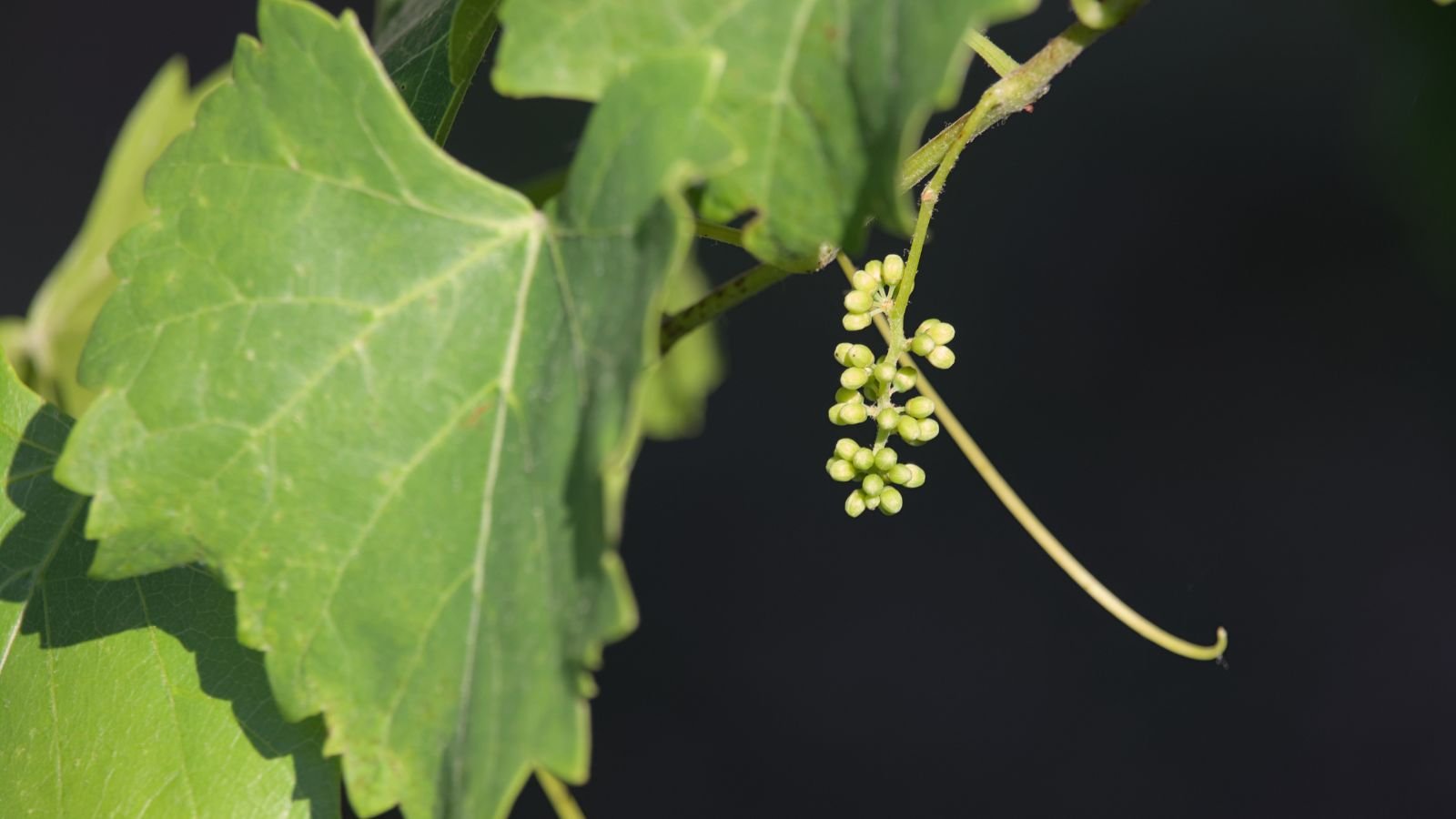
|
|
botanical name Vitis rotundifolia |
|---|---|
|
|
plant type Perennial |
|
|
sun requirements Full sun to partial shade |
|
|
height 15-25 feet |
|
|
hardiness zones 5-9 |
Muscadine grapes are a native North American grape and have been grown in the Southeastern United States for centuries. The flowers are a muted, creamy eggshell white. Once the plant matures, you’ll have a hardy plant that can tolerate heat and humidity better than many other varieties.
Muscadine grapes are also very vigorous growers, and can quickly cover a fence or arbor. Muscadine is resistant to most pests and diseases. It grows well in a variety of climates and soils and is easy to care for.
Potato Vine

|
|
botanical name Solanum laxum |
|---|---|
|
|
plant type Perennial |
|
|
sun requirements Full sun to partial shade |
|
|
height 20-30 feet |
|
|
hardiness zones 9-11 |
The potato vine is a low-maintenance vine you can grow if you like the look of jasmine. This plant is a less fragrant option, with the same delicate white flowers. The plant is native to Brazil, and it is a member of the Solanaceae family.
Potato vine grows quickly and requires little attention other than regular watering. The plant is poisonous to humans and animals, but some cultures use it for medicinal purposes.
Snail Vine

|
|
botanical name Cochliasanthus caracalla |
|---|---|
|
|
plant type Annual |
|
|
sun requirements Full sun to partial shade |
|
|
height 10-30 feet |
|
|
hardiness zones 9-12 |
The snail vine flowers have a distinctive swirling shape, similar to a snail shell. The flowers bloom in the summer and attract bees, butterflies, and hummingbirds. Snail vine grows quickly and thrives on trellises and walls.
Snail vine is an easy plant to grow and care for. It prefers full sun and well-drained soil. This vine is drought-tolerant and does not need much water. Just water the plant when the soil is dry to the touch.
Sweet Autumn Clematis

|
|
botanical name Clematis terniflora |
|---|---|
|
|
plant type Perennial |
|
|
sun requirements Full sun to partial shade |
|
|
height 15-30 feet |
|
|
hardiness zones 4-9 |
The sweet autumn clematis is a vigorous grower, that’s one of many different types of clematis. They can reach heights of 20 feet or more. Sweet autumn clematis is also known as Japanese clematis and is native to China and Japan.
The white flowers release a sweet fragrance. They bloom in September and October and are a great addition to any fall garden.
Sweet autumn clematis is great for use in landscaping, and you can train the plants to grow on arbors or pergolas. If you live inside its invasive range, choose another plant on this list.
White Bougainvillea

|
|
botanical name Bougainvillea spp. |
|---|---|
|
|
plant type Perennial |
|
|
sun requirements Full sun |
|
|
height 15-40 feet |
|
|
hardiness zones 9-11 |
Bougainvillea is a beautiful plant that can add color to any garden. They are super unfussy and easy to grow for a beginning gardener. You can use this bright, cheerful plant as a ground cover, as a border plant, and as a climbing plant.
Bougainvillea is also drought-tolerant, so they are perfect for areas that don’t get a lot of rain.
If you are looking for a plant that will add personality to your garden, then bougainvillea is a perfect choice. Just make sure you give them enough space to grow, as they can get quite large.
White Climbing Iceberg Rose

|
|
botanical name Rosa ‘Korbin’ |
|---|---|
|
|
plant type Perennial |
|
|
sun requirements Full sun |
|
|
height 15 feet |
|
|
hardiness zones 4-9 |
Climbing roses are a beautiful addition to any garden, and they offer many benefits that other types of roses do not. For one, they are very easy to care for and maintain.
Additionally, Iceberg roses are relatively disease-resistant, which means that you won’t have to worry about them getting sick and dying prematurely. And, because they are climbers, they can add a lot of vertical interest to your space.
White Climbing Sweet Pea

|
|
botanical name Lathyrus odoratus |
|---|---|
|
|
plant type Perennial |
|
|
sun requirements Full sun to partial shade |
|
|
height 2-6 feet |
|
|
hardiness zones 2-10 |
Sweet pea is a fragrant and elegant flowering vine. It can be grown in a pot, on a porch, or in a garden, and it will bloom from early summer until fall. The flowers are fragrant, and they come in a variety of colors including white, pink, purple, and red.
The sweet pea plant is a member of the pea family. The flowers grow on a spiky stem that grows from their leaf axils.
Sweet pea is easy to grow from seed, and it will self-seed freely if given the opportunity.
White Coral Vine

|
|
botanical name Antigonon leptopus |
|---|---|
|
|
plant type Perennial |
|
|
sun requirements Full to partial sun |
|
|
height 30-40 feet |
|
|
hardiness zones 8-11 |
White coral vine is a beautiful plant that can grow quickly, making it a great choice for ground cover. It has pretty clusters of pink or white flowers that bloom from late spring to early summer, attracting bees and butterflies.
This plant is native to Mexico and South America, but it can be grown in many other parts of the world. Coral vine is drought-tolerant and can even grow in poor, sandy soil. It is also an invasive plant in many areas.
If you’re looking for a plant that will add interest to your yard, coral vine is a great choice. If you live in Florida, Texas, and Hawaii, opt for a different vining plant as this one is invasive in those areas.
White Flowering Honeysuckle Vine

|
|
botanical name Lonicera albiflora |
|---|---|
|
|
plant type Perennial |
|
|
sun requirements Full sun to partial shade |
|
|
height 3-10 feet |
|
|
hardiness zones 7-10 |
Honeysuckle vine is a flowering plant that is native to the eastern and central United States. It is a woody vine that can grow to be up to 30 feet long.
The vine has small, fragrant flowers that bloom in the spring and summer. The vine produces small, dark-colored berries that are poisonous to humans but are popular with birds.
The honeysuckle vine is a popular plant for gardens and landscaping because of its showy flowers and pleasant fragrance. The vine can be grown in full sun or partial shade and does not require much water.
White Japanese Wisteria

|
|
botanical name Wisteria floribunda ‘Alba’ |
|---|---|
|
|
plant type Perennial |
|
|
sun requirements Full sun to partial shade |
|
|
height 10-30 feet |
|
|
hardiness zones 5-9 |
Japanese wisteria has fragrant white flowers that drip down from the vines in late spring or early summer. The vines can grow up to 30 feet long and the flowers can be up to 12 inches in diameter. Japanese wisteria is a popular plant for gardens and landscaping because of its beauty and fragrance.
Although Japanese wisteria can be a beautiful addition to a garden, it can also be difficult to grow. The vines need a lot of support and can be aggressive growers, especially in eastern portion of North America where they are classed as invasive. They can also be susceptible to pests and diseases.
White Mandevilla

|
|
botanical name Mandevilla boliviensis |
|---|---|
|
|
plant type Perennial |
|
|
sun requirements Full sun to partial shade |
|
|
height 3-10 feet |
|
|
hardiness zones 10-11 |
Mandevilla is a tropical-looking plant that you’ll find in many gardens. It has a pink and white flower and can grow up to ten feet tall.
The vine itself can grow to be quite long. As it grows, you’ll need to provide the vine stems support using sticks or a trellis. The vine is a popular choice for many gardeners because it is easy to take care of and doesn’t require much maintenance.
White Trailing Fuchsia
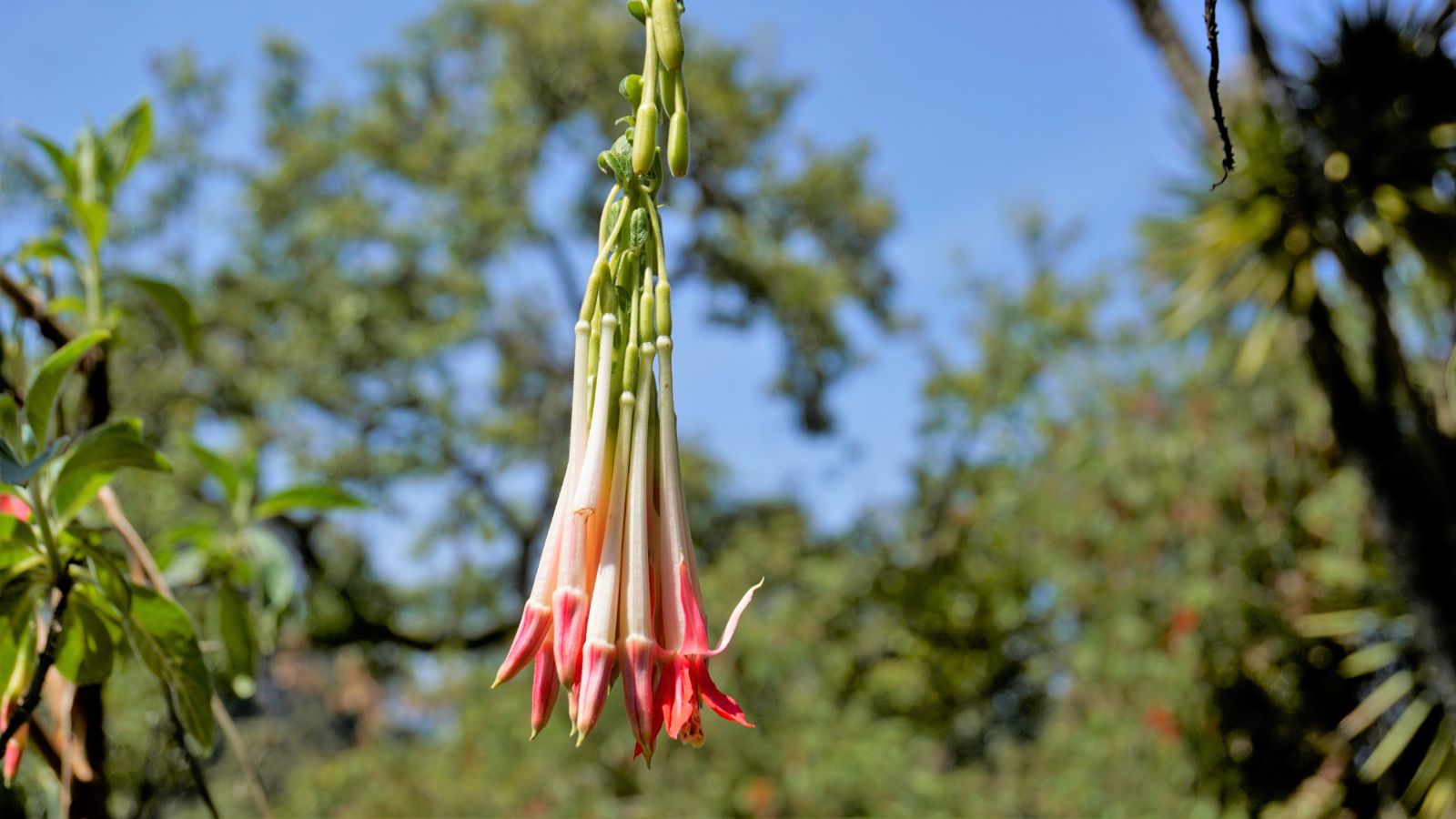
|
|
botanical name Fuchsia boliviana ‘Alba’ |
|---|---|
|
|
plant type Annual |
|
|
sun requirements Full sun to partial shade |
|
|
height 8-13 feet |
|
|
hardiness zones 9-11 |
The Fuchsia boliviana ‘Alba’ is a cultivated Fuschia variant. It has an understated, chic feel to it, with delicate gleaming white flowers and long stems.
This variant is native to Bolivia, and it is also found in Peru and Chile. This plant can grow up to six feet tall, and it blooms from June to August. The white trailing fuchsia is a popular choice for gardens, and it is also used in floral arrangements.
White Trumpet Vine

|
|
botanical name Thunbergia grandiflora ‘Alba’ |
|---|---|
|
|
plant type Annual |
|
|
sun requirements Full sun to partial shade |
|
|
height 6-35 feet |
|
|
hardiness zones 10-11 |
The trumpet vine is native to the Americas but also grows in other parts of the world. Trumpet Vines are fast-growing and can climb up walls or other structures. The flowers are unusually long, with a tube shape that resembles a trumpet.
Trumpet vine plants are beautiful additions to any garden, but they can be considered invasive in some areas. They can grow up to 35 feet tall, so they make a dramatic statement in any space. Trumpet vines are also very easy to care for, and they are drought-tolerant once they establish themselves. They are not for small spaces, though.
Wild Cucumber

|
|
botanical name Echinocystis lobata |
|---|---|
|
|
plant type Annual |
|
|
sun requirements Full sun |
|
|
height 25-30 feet |
|
|
hardiness zones 2-11 |
The wild cucumber vine can grow up to 30 feet in length and is a climbing plant. The leaves are large and lobed, and the flowers are greenish-white in color. The fruits of the plant are cucumber-shaped and can be either green or yellow.
The wild cucumber is a member of the gourd family, which also includes squash, pumpkins, and melons. This vine is not the same as the cultivated cucumber (Cucumis sativus), which is a different plant altogether. The wild cucumber is not edible, and in fact, its fruits contain a substance that can be irritating to the skin.
Wire Vine
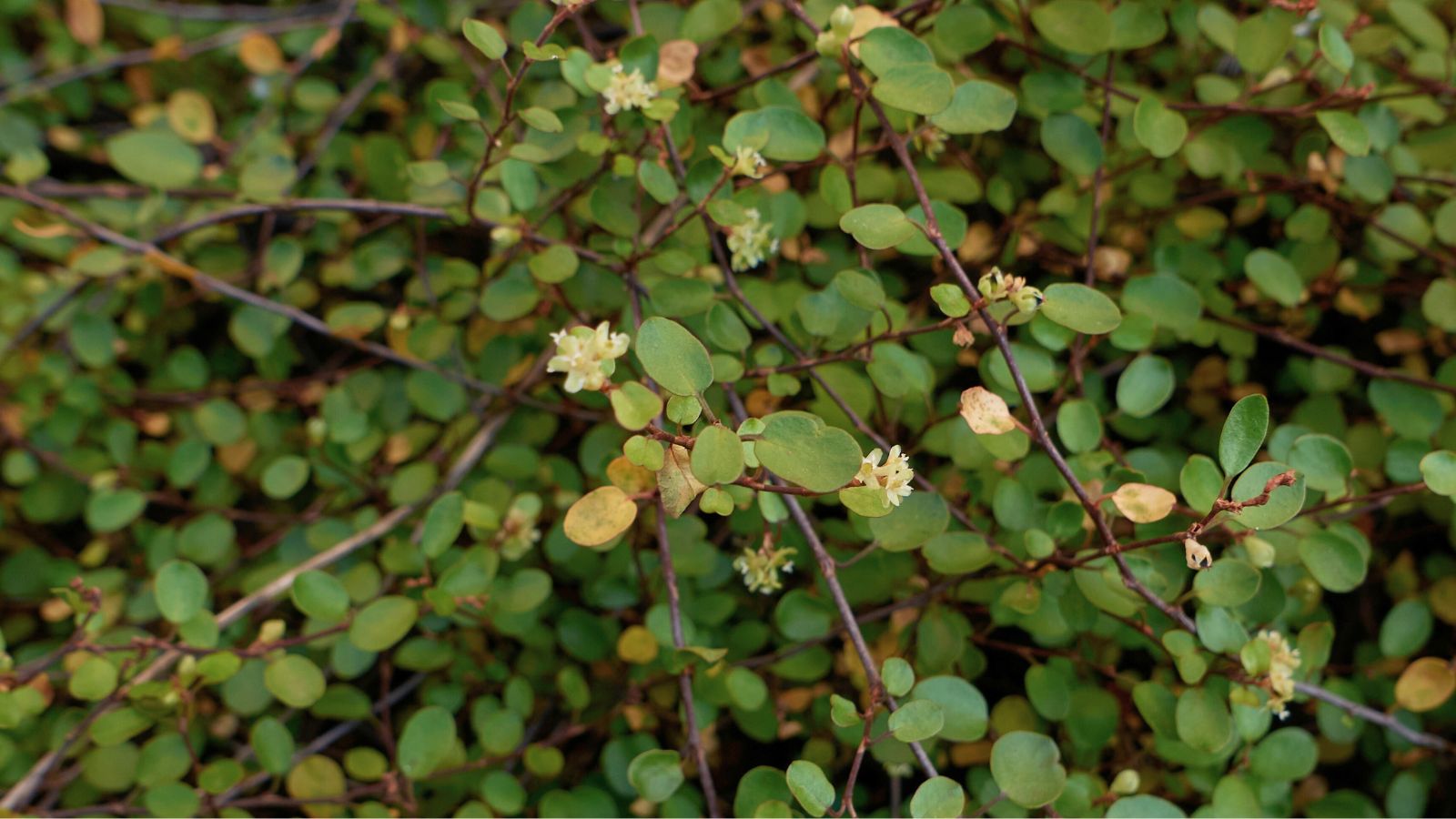
|
|
botanical name Muehlenbeckia axillaris |
|---|---|
|
|
plant type Evergreen |
|
|
sun requirements Full sun to partial shade |
|
|
height 3 feet |
|
|
hardiness zones 5-9 |
Wire vine, also known as cobweb spiderwort, is a fast-growing vine native to New Zealand. It is a popular plant in gardens and as a houseplant, due to its trailing habit and small leaves.
Wire vine spreads quickly, and the vine can reach lengths of up to 6 feet. It has small, oval-shaped leaves that are dark green. It produces small white flowers every summer. Wire vine is tolerant of a wide range of soil types and prefers full sun to partial shade.


